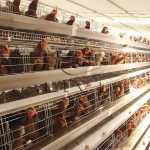In the dynamic world of poultry farming, efficiency and productivity are paramount. As the demand for poultry products continues to rise, farmers are increasingly turning to technological advancements to streamline their operations. One such innovation is the automatic broiler feeding and drinking line, an essential component for large-scale poultry farms housing up to 30,000 chickens. This article delves into the benefits, features, and implementation strategies of these automated systems, providing insights for poultry farmers looking to enhance their farm operations.

The Importance of Automation in Poultry Farming
Automation in poultry farming is not just a trend; it’s a necessity for modern agricultural practices. With the ability to manage large flocks with minimal human intervention, automatic feeding and drinking systems help farmers save time, reduce labor costs, and improve the overall health and productivity of their poultry.
Key Benefits of Automatic Broiler Feeding and Drinking Lines
- Efficiency and Time-Saving: Automated systems can significantly reduce the time spent on manual feeding and watering. This allows farmers to focus on other critical aspects of farm management.
- Consistent Nutrition and Hydration: These systems ensure that chickens receive a consistent supply of feed and water, promoting uniform growth and reducing stress among the flock.
- Reduced Waste: With precise control over feed and water distribution, automatic systems minimize wastage, leading to cost savings and a more sustainable farming operation.
- Improved Biosecurity: By reducing human interaction with the flock, automated systems help lower the risk of disease transmission, enhancing the biosecurity of the farm.
Components of an Automatic Broiler Feeding and Drinking Line
An automatic broiler feeding and drinking line comprises several key components, each playing a vital role in the system’s overall functionality.

Feeding System Components
- Feed Silo: The feed silo stores large quantities of feed, ensuring a steady supply to the feeding lines. Made from durable materials like hot-dip galvanized steel, these silos are designed to withstand harsh environmental conditions.
- Main Feeding Line: This line transports feed from the silo to the individual feeding pans. Equipped with sensors, it can automatically adjust the feed flow to maintain optimal levels.
- Pan Feeders: These are strategically placed along the feeding line to distribute feed to the chickens. Each pan can accommodate 30-35 broilers, ensuring even distribution across the flock.
Drinking System Components
- Water Storage Tanks: These tanks supply clean water to the drinking lines, ensuring that chickens have constant access to fresh water.
- Nipple Drinkers: Designed to minimize water wastage, nipple drinkers dispense water only when touched by the chickens. They are fitted with cups to collect any excess water, keeping the chicken house dry.
- Water Regulators: These devices control the water pressure in the lines, ensuring a consistent flow to all drinkers.
Implementing an Automatic Broiler Feeding and Drinking Line
Implementing an automatic broiler feeding and drinking line requires careful planning and consideration of several factors, including the size of the chicken house, the number of chickens, and the available resources.

Planning and Design
- Assessing Farm Needs: Determine the specific needs of your farm, such as the number of chickens and the layout of the chicken house. This will help you choose the right system size and configuration.
- Customizing the System: Many manufacturers offer customizable systems to fit the unique requirements of each farm. For example, the system can be tailored to the dimensions of the chicken house or the desired feeding schedule.
- Installation and Setup: Proper installation is crucial for the efficient operation of the system. Work with experienced professionals to ensure that all components are correctly installed and calibrated.
Maintenance and Monitoring
- Regular Inspections: Conduct routine checks on the system to ensure all components are functioning correctly. Look for signs of wear and tear and address any issues promptly.
- Data Monitoring: Use data from the system’s sensors to monitor feed and water consumption. This information can help you make informed decisions about feed management and flock health.
Success Stories from Around the World
Several poultry farms worldwide have successfully implemented automatic broiler feeding and drinking lines, reaping significant benefits.

- Zimbabwe: A poultry farm in Zimbabwe implemented an automatic system for 30,000 chickens, resulting in improved feed efficiency and reduced labor costs. The farm reported a 5-star satisfaction rating, highlighting the reliability and effectiveness of the system.
- Uzbekistan: In Uzbekistan, a farm with 20,160 chickens experienced enhanced productivity and flock health after adopting an automated feeding and drinking system. The farm owner praised the system’s ability to provide consistent nutrition and hydration.
Conclusion
The integration of an automatic broiler feeding and drinking line is a game-changer for poultry farms aiming to scale their operations sustainably. By ensuring consistent feed and water supply, reducing waste, and enhancing biosecurity, these systems offer a comprehensive solution for modern poultry farming challenges.
For farmers looking to optimize their operations, investing in an automatic feeding and drinking line is a strategic move towards achieving higher efficiency and profitability. As the industry continues to evolve, embracing such innovations will be crucial for staying competitive and meeting the growing demand for poultry products.
Call to Action
Are you ready to transform your poultry farm with an automatic broiler feeding and drinking line? Contact industry experts to explore customized solutions tailored to your farm’s needs. Embrace the future of poultry farming today and ensure a prosperous tomorrow for your business.





